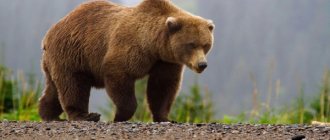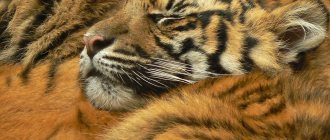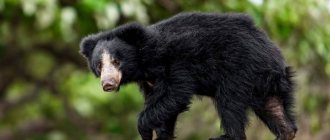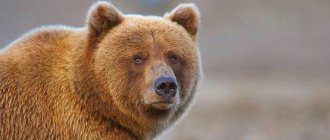Introduction
Is it possible to kill a tiger or a lion with your bare hands?
I think this question is almost as interesting to many as the question - who is stronger, the tiger or the lion? The question has an ancient history. Different peoples have many stories about people killing big cats without weapons. But what do they reflect? Maybe more like a dream? Or exaggerated exploits of real heroes? Or is it still sometimes possible for a person to kill a tiger with his bare hands?
Hard to say. There is no definite answer to this question, since most of these stories are devoid of details (and when details appear, it is often possible to figure out a lie). We do not have video recordings of such feats. Many data cast doubt on such stories. But, on the other hand, in some cases relatively realistic ways for a person to kill a big cat are described. Although, this also looks realistic only in theory. In practice, we have too little data on this issue to judge more specifically.
If we change the strength of a person in representatives of the genus Panthera (which includes: lion, tiger, leopard and jaguar), then the upper limit of a person can be called victory over a leopard. Higher achievements are not certain, or doubtful.
Here we will talk specifically about some kind of lion or tiger. Who is stronger: the strongest lion, or the strongest man, there is no question. Leo is stronger. As the Arabs say, “Allah gave a man the strength of a man, and a lion the strength of forty men.”
Who is stronger: tiger and bear
Will an Amur tiger be able to defeat a brown bear?
A bear and a tiger are more likely to meet in nature, since striped cats are widespread in the same area as the clubfoot (meaning Amur tigers), so their possible fight should be considered first.
The main prey of the striped taiga hunter are wild boars and wapiti, but having successfully chosen the size of a small clubfooted tiger, it is capable of attacking a bear. Small females or cubs may well be part of a cat’s diet, which cannot be said about large representatives of the species.
The bear itself rarely attacks others, but is capable of breaking the spine of a cow or elk with one blow, so it cannot be considered a bad fighter. In addition, its claws are not retractable and are much larger than those of a tiger. The striped one will not be able to pierce the thick skin of the furry one with its claws and the bet on victory will be only due to its dexterity and sharp teeth.
If we take into account other, larger bears, for example, white, then the outcome will be obvious. The polar bear is today's largest predator
Its weight can reach a whole ton, and its impact force is twice that of any brown bear. A cat simply cannot significantly injure a white one through its thick skin, and he, in turn, can send a tiger to the next world with one blow. If we consider the fight of a tiger against an ordinary brown one, then out of 10 fights the cat will win in 6, but much depends on secondary circumstances.
Several fights in detail
Around 2009, a fight was recorded between a tiger weighing approximately 205 kilograms and a young female bear weighing 200 kilograms. According to an eyewitness, the instant killing did not work out, which, in fact, tired the predator. But the bear could not kill the tiger. It is quite possible that there were not enough claws and teeth. As a result, the animals dispersed.
In 1997, there was a fight between a female bear, who was giving birth, and a tiger. The latter was the initiator. As a result of falling from a small slope, the animals grappled and flew several meters down. A few minutes later, the tiger won the fight, but received a serious wound, so he was forced to lie down nearby. The cubs managed to escape during the fight.
From all of the above, we can conclude that the outcome of the battle largely depends on what kind of victim the tiger chooses. The characteristics of potential prey are always inferior to those of the predator. This is due to the fact that if you come across a very large bear, it will be very difficult to defeat it.
Brown bear versus Ussuri tiger
Bear and penguin. Why doesn't the polar bear eat penguins?
44 cases of collisions are known
But upon careful study of the relationships between these animals, it becomes clear to scientists that the brown animal behaves more aggressively, especially during periods of lack of food. And the striped one tries to attack small individuals. The tigress enters into a fight with any clubfoot and sacrifices herself to protect her cubs.
There is a described case of a fight between a large tiger and a she-bear.
The tiger attacked a ten-year-old female bear weighing about 180 kg. At the site of the fight, an area of 8 meters was formed. After the victory, the tiger stepped aside 15 meters to catch its breath. A wound on his body was bleeding.
As you can see, a large male weighing about 205 kg had a difficult fight with a female bear, whose weight was no more than 200 kg. Even a victim smaller than himself could turn an instant kill into a long struggle, which became so tiresome for him. Thus, if in the place of the bear there was a large male weighing about 380 kg, it is unlikely that he would become a victim.
The larger the clubfoot, the lower the tiger's chances of winning. This is not an elephant; there are no places on its body that, by clinging to which the tiger itself could remain out of reach. Therefore, with a bear, the tactic of eating him alive is doomed to failure. He is not a buffalo to just let him grab his throat. Even if we manage to do this, the bear will still have free paws, just enough to break the tiger’s back. A tiger is not too large an animal to fail to break its spine.
The paws of the clubfoot seem to be created to break ridges. He is able to break the spine of an elk, a wild boar, thus a strong blow to the back from above, as well as a headlock in a duel - and there is no tiger. He is not able to stand against him on his legs, they do not have enough strength; standing on his hind legs, the bear is still more stable.
Tactics and technique
uses monotonous tactics
The only chance of success is the killer's quick tactics. The enemy's weak spot is the throat. If the striped one could grab it around its entire circumference, grabbing the arteries and squeezing, then the bear’s resistance would soon come to naught, because the carotid artery was compressed. But will it be possible to pull this off? It is necessary to grasp this powerful neck, and in large representatives it has excellent protection in the form of muscles that protect the trachea and arteries, located very deep. The big guy puts up active resistance and can grab him by the throat. Thus, whatever one may say, such fights can often end not in favor of the tiger.
A bite in the throat, as the only chance to resist the enemy, is illusory for a tiger.
Educational facts
In most cases, the tiger's failure in the first attack leads to its defeat. Moreover, the larger the bear, the more difficult it is to defeat it. This is due to the fact that he is stable, hardy, and there are no places on his body where he could cling to with impunity. Moreover, every tiger strike ends with him receiving a strike in return. Of course, there are so-called “upsets” - exceptions to the rules. So, according to these very exceptions, large tigers can even defeat Kodiaks, giant bears. However, there are no reported cases of this yet. The bear has very monotonous tactics; it always tries to crush the victim under itself, and then breaks its spine. In some cases it bites the scruff of the neck.
Himalayan bear vs tiger
White Tiger
The famous naturalist Jim Corbett claims that he has more than once seen Himalayan bears confidently and fearlessly chasing away tigers at the most inopportune moment, when they were having a nice lunch. The Himalayan bear has a courageous and aggressive disposition: sometimes it attacks tigers, which larger brown bears avoid. However, unpredictable endings also happen when two formidable predators come into conflict.
Well, who is stronger, the clubfoot or the striped one? With equal sizes, these animals are almost equal in strength. But there are nuances:
The one who is older, braver and meaner will win. The young males of one and the other camp fight less skillfully than the seasoned ones, who are full of strength and courage. An important point in favor of one of them is who attacked first, as well as who is full or hungry
A well-fed predator is not as angry and impudent as a hungry one. It is also important on whose territory the opponents met: whoever has a closer house fights more fiercely. Fury is often stronger than strength.
One can imagine an equal fight of one weight category, which ends with the victory of a feline representative, but his chances of meeting the largest representatives of this species are negligible. Be it Kodiak, Kamchatka giant, grizzly or white. Even brown individuals can reach a weight of more than 700 kg. Their mass, endurance, and blunt force beat all the opponent’s trump cards. The clubfoot is not a buffalo that can be killed by cutting its tendons. Is it really possible to kill a giant in the first 5 minutes, if it is not always possible to kill a buffalo?
What usually happens
Some clarification is needed here. We do not clarify the question: who is stronger, man or tiger? Because it's obvious. We are only finding out whether any person can kill any adult tiger at any time?
For clarity, let's clarify what this means.
No one doubts that a boxer is stronger than a drunk or a drug addict. However, it was sometimes recorded that people who had no idea about boxing on the street broke the jaws of boxing masters (or famous karatekas).
There was a case where retired boxer Ray Mercer knocked out former two-time MMA champion Tim Sylvia, but that doesn't mean that boxers will always win in MMA?
Should people at least count on such exceptional cases in the fight against tigers?
What usually happens?
I want to draw the attention of readers to the existence of such a phenomenon as cannibalistic animals. If “man in general” were stronger than “tiger in general,” then there would be no man-eating tigers
There was a case when a tiger killed an Indian elephant. But, nevertheless, there are no elephant-eating tigers. Because despite the exception, tigers usually cannot cope with an elephant. But with a person, you know, they can! In the book about the cannibal lions of Tsavo, a case was described when a lion killed a man famous for his incredible strength. It didn't seem like there was any difference between him and other people =).
If people were stronger than lions, they would not need to invent weapons. Just like a gorilla is the strongest in its ecosystem, and is in no hurry to make a spear to fight a leopard. It was the vulnerability of the human body that forced him to invent ways to counteract the monstrous power of animals.
Further
Let's pay attention to the demonstration games of antiquity (a la Ancient Rome). Confrontations between humans and animals were demonstrated here
But people were always armed, unless they were criminals sentenced to death. If even super-strong people could sometimes defeat lions and tigers without weapons, then why wasn’t this shown in Ancient Rome? This is interesting! And human life was not so valued there. This means that it was not considered wrestling, but simply feeding lions and tigers.
I would also like to draw attention to such a school as training large predators. It is never built on physical dominance of a person
If there were some strong men who were stronger than tigers, then why not trust them to train them? Why then invent ways to create the illusion of human superiority?
Since ancient times, all kinds of strongmen have performed in the circus, who “break chains with the movement of their shoulders.” But for some reason, it is not they who train lions and tigers, using their strength, but special trainers, using their knowledge.
And, by the way, the act “fighting a lion,” for example, has never been common in the circus. What does it mean? That the legendary circus strongmen are too little even against zoo animals
By the way, if such a fight was organized, it was with all the precautions (a half-dead old lion with its paws and mouth tied). After all, it is within the power of a person to choose a “convenient” lion, but it is not within the power of a lion to choose a convenient person! True, we can be sure of the outcome of the “struggle” of the second pair...
Lion attack on Dave Selmoni
For example, the attack of the usual circus lion Bongo on Dave Salmoni. I don't think anyone can doubt that Salmoni is physically superior to the average male human (and certainly physically superior to some of his internet haters). While Bongo is an ordinary small circus lion (just like Vasya). And in this case, too, there was no talk of fighting. Salmoni had one task - to escape. And he himself said that he was on the verge of death. He needed psychological recovery from close “communication” with the fangs of a lion.
the average lion and tiger are stronger than the average man; they are stronger and very strong people; and in general, it seems that they are usually stronger than even super strong people
And outstanding lions are even capable of defeating crowds of people with firearms and knives!
That is why the title of the article is not “Who is stronger, man or tiger?”, but “Can man...?”
Basic characteristics of animals
The Amur tiger “calms” its prey with one powerful bite. In turn, a bear can break a cow's neck, and it costs him nothing to kill an elk.
Yes, the brown bear is very strong, you can’t argue with that. But the Amur tiger, like all wild cats, is quite agile.
And also, unlike a bear, he has more practice, since a tiger eats exclusively meat, and bears eat more plant foods.
At the same time, Amur tigers rarely attack brown bears.
They hunt wild boars and other living creatures, but they behave very carefully with bears - a fight with Potapych could end disastrously for them
And yet, such fights sometimes occur.
The tiger has sharp teeth, strong jaws, sharp claws and a powerful paw in its arsenal. Speed and agility should not be discounted either.
The brown bear is less agile, but very strong. He will easily defeat any opponent. Power and strength are a serious claim to victory.
A bear, especially if you make him angry, will tear anything and anyone apart.
The main source of his strength is his powerful back muscles and forearm. In addition, bears also have fangs and huge claws (though they are blunt).
By the way, unlike a tiger, a bear is more resilient.
The outcome of a fight between an Amur tiger and a brown bear is very difficult to predict. But we'll try.
In general, it should be noted that in most cases, a tiger and a brown bear prefer to stay away from each other.
These animals do not hunt each other, but they can still collide when not sharing the prey or when their offspring are in danger. Which of them will be stronger?
The tiger is a born hunter. He attacks quickly and decisively, timing his throw with the precision of a professional.
But the brown bear can be called an adventurer. He achieves his goal with the help of endurance and strength.
It should be noted that, being heavier than a tiger, the bear is less bloodthirsty - he is mainly a vegetarian.
Yet its mouth is full of large, sharp teeth, and its paws end in long claws. Therefore, the brown bear is a worthy opponent for the Siberian tiger.
Who is stronger in a fight?
Situations when a tiger and a polar bear can meet are not very frequent, but possible. Most often, a tiger has no chance in a fight with a bear, because the bear has enormous dimensions. The larger the bear, the more difficult it will be for the tiger to defeat it. With one bite or blow, a polar bear can break a tiger's spine or wring its neck.
Thus, a polar bear has a better chance of surviving a tiger attack, often due to its mass, sharp claws and a large layer of subcutaneous fat, which protects it not only from cold, but also from injury.
Who is stronger - a bear or a tiger: statistics
According to hunters, a tiger is easier to kill. However, this animal is many times more dangerous than the same bear or cleaver. If the latter run away when they sense danger, especially if they hear the sound of a shot, then it is difficult to predict the tiger’s reaction. It is likely that he will attack the hunter. To date, 44 cases of bear-tiger collisions have been recorded. In 50% of cases the bear died. About 27% of fights ended in the death of the tiger, and in 23% the feline ran away from the battlefield. Another interesting point is that 12 fights were initiated by the tiger, and the bear – 8. It is not clear who was the aggressor in the remaining cases. From the statistics it is clear that the tiger is somewhat stronger; it also initiates conflict more often and suddenly attacks. If the fight drags on, the cat either dies or leaves the fight. But if a tiger can escape from the battlefield, then a bear cannot, since the speed of cats is somewhat higher. It is also interesting that it is the tiger who chooses its victim, since it is the aggressor. It is unlikely that he will choose a brown bear, which significantly exceeds him in mass.
Description of the tiger in detail
It's no secret that cats are considered ideal predators. Their diet consists of 100% animal meat. From this we can conclude that the only thing the tiger does is hunt. Almost every day an adult predator can go hunting and bring back prey. But there are also sad cases. For example, a fight with a large cleaver more than once ended in defeat for the feline. As a result of a bloody fight, both the wild boar and the tiger can die. The main disadvantage of these predators is that they are prone to panic during a fight, and nothing can be worse than this. The weight of a tiger often reaches 300 kilograms, which means that it is a very dangerous massive predator, but a long fight and retaliatory strikes from the prey can confuse it.
Ussurian tiger
The tiger is a special animal, it never hurts its victims, it always kills them the first time. He has unusually sharp claws (although they are smaller than those of the clubfoot), and with his fangs he is able to tear apart an opponent in one fell swoop.
Ussuri tiger... YouTube
When hunting small deer, it is enough for a tiger to hit the victim on the spine with one paw. When hunting game, it grabs it with its paws and bites it hard by the mane. Then it bites through the spine and nervous system so that the victim cannot resist. However, that's not all this animal can do.
The tiger is a fast and agile animal. This predator tries to be the winner from the first blow. He doesn't like long battles. This animal is also known to panic, especially if something doesn’t work out. And it also happened that the animal only wounded its victim and simply ran away from the scene of the fight.
Tiger
Today, there are 6 subspecies of tigers living on the planet with a total number of 5000-6500 individuals. The easiest one to meet is the Bengal tiger , since it alone occupies almost half of the entire population. The historical habitat of big striped cats is Asia:
- Iran;
- Far East;
- China;
- India;
- Afghanistan.
Absolutely all tigers are territorial predators, leading a solitary lifestyle and fiercely defending their hunting grounds from the encroachments of other mammals. The weight of an adult can reach 250 kg, while the tiger is very agile and fast, but this is not enough for a long fight or hunt. The predator's fatigue and fear of injury lead to the fact that the animal will not oppose the opponent if he gives such an opportunity.
Who will win - the bear or the tiger? Some statistics.
Hunters claim that it is easier for them to deal with a tiger, since this animal is several times more dangerous than a bear or wild boar. Hearing a shot, a wild boar or bear immediately begins to run away, but the actions of a tiger are unpredictable. It can sometimes attack humans. In fights between a tiger and a bear, the tiger won in half the cases.
Tigress with a tiger cub... YouTube
Approximately 27 percent of the battles were fatal to the tiger, and in 23 percent the tigers fled from the battles. It is also known that the instigator of the fights was both a tiger (12 cases) and a bear (8 cases). Hence the conclusion: the tiger is stronger, because it is the first to enter a fight and attack.
If the fight between the rivals does not end quickly, then it is clear that the tiger dies or leaves the fight. But the bear does not escape from battles. The main thing here is that the tiger, which is very aggressive, chooses the victim. But it is unlikely that he will choose a bear that is much heavier than him.
Who will win - the bear or the tiger? Some statistics.
Hunters claim that it is easier for them to deal with a tiger, since this animal is several times more dangerous than a bear or wild boar. Hearing a shot, a wild boar or bear immediately begins to run away, but the actions of a tiger are unpredictable. It can sometimes attack humans. In fights between a tiger and a bear, the tiger won in half the cases.
Tigress with a tiger cub... YouTube
Approximately 27 percent of the battles were fatal to the tiger, and in 23 percent the tigers fled from the battles. It is also known that the instigator of the fights was both a tiger (12 cases) and a bear (8 cases). Hence the conclusion: the tiger is stronger, because it is the first to enter a fight and attack.
If the fight between the rivals does not end quickly, then it is clear that the tiger dies or leaves the fight. But the bear does not escape from battles. The main thing here is that the tiger, which is very aggressive, chooses the victim. But it is unlikely that he will choose a bear that is much heavier than him.
What else is interesting about the owner of the forest?
We can say with great confidence that the clubfoot is very well adapted to a long fight. He is a very stubborn fighter, so he will stand to the last, unlike almost any tiger. Although there are cases where the persistence of cats did its job. In principle, tigers are very unpredictable; they can first run away, and then change their minds and return. Here you can find slight similarities with domestic cats, whose behavior sometimes defies explanation.
We have already figured out what the brown bear eats, and you know that it is omnivorous. For this simple reason, this animal is less aggressive. The exception is a female with offspring. In this case, her rage will be higher than any hungry cat, but not a cat with kittens. But fights between such females have not been recorded. By and large, the mobility of a bear is somewhat lower than that of an adult cat, however, it is many times more resilient.
What a polar bear is capable of
The polar bear is a true master of adaptation. In harsh arctic conditions, it manages to practically not lose heat. Several features help him. Firstly, its fur is completely devoid of pigmentation, and the skin underneath is black. This allows the bear to capture the meager warmth of the Arctic sun and not lose it. The only thing that gives off heat is its nose, which the polar bear covers with its paw in its sleep. This is why the polar bear is practically invisible in an infrared image.
The polar bear is the largest predator on the planet. Its weight reaches a ton, its body length is three meters.
Polar bears are excellent swimmers and can cover enormous distances (a case was recorded when a female bear swam 600 kilometers in search of food!)
Despite such considerable weight, the polar bear is an excellent runner and reaches a speed of about 40 km per hour. True, not for long - long running can lead to overheating due to the nature of heat transfer.
The layer of subcutaneous fat is another excellent heat insulator, plus a reserve for a rainy day and a kind of “body armor” 13 cm thick.
Lion and bear: who is faster?
In order to compare the strength of predators, you will need knowledge of the speed limits of the competitors.
Lions in the wild can reach speeds of up to eighty kilometers per hour. They easily catch nimble antelopes, maneuvering remarkably well. Its flexible body and long tail help it jump up to three meters, which is an important hunting skill.
Also, lions are not the toughest of animals. They have a very small heart compared to their body weight and size, so they cannot maintain high speed for a long time. It is not uncommon to see an adult lion walking slowly after a failed hunt. Other cats that do not catch the prey the first time try again immediately. And a lion needs to rest in order to regain strength, even if the prey is very close.
Bears, unlike a lion, are not so fast, but still do not confirm the prevailing opinion about their slowness. The heavy predator reaches speeds of up to fifty-five kilometers per hour, and can maintain it for a long time. Bears, although clumsy, are very stubborn. If he has identified a victim, then he will chase it for several kilometers over a long period of time. That is why, when meeting the brown owner of the forest, do not attempt to escape. The bear will not stop, and you will get tired much faster than him.
Lion habitats
Lions are distributed on two continents: Africa and the Asian part of Eurasia. Many prides live in India (Gir forest), and in Africa they are found mainly in the southwest. They inhabit savannas, sometimes venturing into forests or dense bushes. Previously, these big cats lived almost throughout the entire territory of our planet, but people exterminated them and contributed to extinction in certain areas due to environmental disturbances.
When meeting a person, a lion will show curiosity rather than aggression. People are not of interest to this cat as food. If the person himself begins to throw different things and wave his arms, then the lion, of course, will defend himself, and the instigator of the quarrel will not be able to escape. In most cases, a lion will avoid getting to know a person closely and, sensing his scent from afar, will disappear in another direction.
The heroic strength of bears
At the zoo, near the pen where the brown bears are kept, there is always a crowd of people who watch with interest the behavior of these powerful animals. And how can one not look at the huge, seemingly clumsy animals that walk freely on their hind legs, fight like people, or, lounging on their backs, scratch their belly with their front paws.
They are so huge, but how much good nature they have! - people sometimes say about the local bears.
However, those people who constantly deal with these animals trust them less than any other animal, since a good-natured huge bear can “become brutal” completely unexpectedly. From a very young age, clubfooted people exhibit a very unbalanced character.
An enraged bear is very swift and unpredictable, and its heroic strength is sometimes incredible. There have been several cases where bears have surprised many with the colossal strength of their muscles.
One day in winter we had to put a brown bear indoors for several days in order to clean his enclosure during this time. The bear, who had previously lived in an open enclosure, drank water from a wide ditch, always filled with water, in the summer, and ate snow in the winter. They forgot to put a drinking bowl with water in a closed room. The bear ate meat, ate bread, and thirst began to torment him more and more. He approached the window, but the snow lay on the other side of a very thick grille, reinforced with through iron bolts and nuts.
On the second or third day, in the corridor, near the bear’s room, someone turned on a water tap. The huge bear, hearing the murmur of water, began to bend and twist the thick bars of the lattice; his heroic strength seemed to know no bounds.
A few more minutes and the exit from the cage would be free. Somehow we managed to drive the bear away to the opposite wall. Then the excited beast reared up, grabbed the massive frame with its powerful paws and tore it away. The nuts of the bolts fell down like nuts, and the beast itself, along with the frame, fell on its back. Getting up, he stuck his paw through the window, scooped up some snow and began licking it greedily. Then everything became clear; it turns out they forgot to give the bear something to drink.
When the bear was given water and he emptied two watering cans, his excitement instantly subsided. Having calmed down and lounging on his back, he began to flirt with us: as if jokingly, he pressed his paw against a large iron poker, which we could not pull out of the cage.
Another time, our huge bear pulled into his room a very thick and long iron hook, which was used to clean his cage. With this hook, he went out into the clearing of the corral, sat down comfortably and began to “demonstrate” in front of everyone what his heroic strength was. He held one end of the hook under his arm, and with his free paw he easily twisted the iron around his neck.
We were alarmed, how can we remove this clamp from the bear, if the only way to straighten the ill-fated hook is by heating it red-hot and using a blacksmith’s hammer?
But the mighty beast immediately easily unwound the thick iron rod and began to bend spirals from it. Having completed all sorts of curlicues, the bear calmly went to bed.
In the walking area allotted to the bear, two thick oak trees grew from the same root. When the bear was first released into this clearing, he carefully began to examine and touch everything that caught his eye. He was also interested in trees. The huge beast rested its back against one of the oaks, and its front paws against the other, and pressed so hard that the tops of the tall trees swayed and moved slightly in different directions.
And such a massive, clumsy, seemingly, beast wanders completely silently through the forest. They say about an awkward person that he breaks in like a bear in the thicket of a forest. However, the bear walks through the taiga strewn with dead wood in such a way that very rarely a dry branch can crunch under its wide paws. Even when frightened by a hunter, a huge bear running at a trot makes almost no noise.
By innate habit, he mechanically, but with great precision, steps over dead wood and windfall. It is clear that with such dexterity this forest strongman can silently sneak up against the wind even to a sensitive, fleet-footed elk. These are the forest giants, the bears, and their heroic strength.
Thank you for your attention, my precious reader. You can receive my articles in your email if you subscribe in the upper right corner of the site
Visit the website. I am always glad to see you and I am sure that you will definitely find something interesting for yourself.
Sincerely, Natalya Alexandrovna.
All articles
Who is stronger?
No matter how beautiful and graceful the lion is, victory in the fight here would definitely go to the polar bear. Firstly, it is simply four times heavier and is capable of crushing a lion with its mass. The striking force of a polar bear is almost as much greater.
Its additional advantage is subcutaneous fat, the thickness of which is greater than the length of the claw of the largest lion, so that the lion simply cannot damage a single vital organ of the bear
As a result, the polar bear, the closest relative of our brown bears, turned out to be much more effective, adaptable and dangerous.
It is not for nothing that Leo is called the king of beasts. He is beautiful, fast and dangerous, he is an effective predator. But he reigns only in Africa, and in the cold Arctic the crown of the monarch is rightfully worn by the polar bear. Let's try to figure out who could be the winner in a direct confrontation between these two animals, who is stronger - a lion or a polar bear? For what
—>
Why is the lion the king of beasts?
The lion is the king of beasts, because he is one of the most social predators with a pronounced hierarchy, such a hierarchy can only compete with wolves. Most often, lions live in groups. Such a group of lions is called a pride and consists of one or more males, 5-6 females and their cubs.
Interesting materials:
How long is the low priority queue lol? How long does PMS last for girls? How long does it take to cook potatoes in the oven? How long does it take for goods from Ozone? How long do fines from cameras last? How long do ground flax seeds last? How long does plaster last? How long can homemade products be stored? How long can Greek salad be stored? How long can copper sulfate be stored?
Polar bear and Amur tiger
First, let's look at the pair of the strongest - the polar bear versus the Amur tiger. The advantages of a polar bear are visible to the naked eye. It is strong and very large, in addition it has a strong blow of about 1.5 tons, this indicates good muscle mass. He also has quickness and sharpness of impact. The average weight reaches 450 kg, it is twice as heavy as a tiger. The white strongman has a height at the withers of 130 -150 cm, which is slightly more than the Amur tiger, which has an average height of 120 cm.
Scientists are confident that the force of the blow possessed by the clubfoot is capable of breaking the tiger’s back, causing it to instantly lose its life.
Everything is clear with large specimens of clubfoot, but what about their less powerful brothers? Perhaps not everything is so obvious here.
Lion's punching power
So who is stronger - a bear or a lion? We have looked at the strength of the bear, now let's study the lion.
If a cat with a mane wants to hit you with its paw, then at least half a ton of weight will fall on you. This would be enough to break the legs of a buffalo or the back of an antelope.
The lion's claws are shorter than those of the bear; they reach seven centimeters in length. This weapon is very dangerous and is the main thing for capturing the victim, but not for killing him. With its claws, the lion firmly holds future food or fights with enemies; they are retracted and released at his will.
Its eight-centimeter sharp teeth help the lion kill its prey. It is impossible to free yourself from the grip of a huge cat, as the jaws are compressed with a force of 160 atmospheres! This is twice the force of a bear's teeth.
We weigh the pros and cons and draw conclusions
The brown bear is slightly larger in size than the Amur tiger, and the bear also exceeds the cat in mass (almost 1.5-2 times).
The bite force of a brown bear is 50-60% greater than that of an Amur tiger. At this stage, the advantage is on Potapych's side.
If the tiger delivers mainly targeted bites, choosing the most vulnerable places (this is mainly the neck), then the bear bites its prey wherever it needs to.
Thanks to the enormous strength of its jaws, any bite can be deadly.
A tiger's front paws have strong muscles and are slightly curved inward to make it easier for him to grab and hold prey. When the tiger is not hunting, its claws are retracted, making them always very sharp.
The bear's powerful paws end in huge claws, which it uses mainly to search for food. The bear turns over stones, climbs into the hive, and digs the ground.
When attacked, these same claws are capable of tearing the enemy into pieces. Yes, unlike a tiger's, a bear's claws are blunt and do not retract inwards, but they are long and strong.
Both the tiger and the bear are capable of delivering strong blows with their paws. The difference lies in the claws.
The tiger cuts the muscles, weakening but not killing its prey. A bear usually breaks the spine with a blow from its paw, causing a fatal blow.
The tiger is inferior to the bear in strength and endurance, but the cat is much more agile and faster than the clubfoot. Could this be the deciding factor in the fight between these heavyweights?
I think yes. Speed matters a lot.
The brown bear is large and very strong, but it has an “Achilles heel” on its body - a weak neck. If the tiger gets to her, the bear will have no chance.
Statistics tell us that in 55-60% of cases tigers defeat bears. But in some situations, they themselves can become a victim. After all, a bear is a strong animal that can fight back.
Answering the question: “will the Amur tiger be able to defeat the brown bear?”, we can definitely answer that it can. But it won't be easy. The outcome of such a fight directly depends on the time of year and the physical characteristics of the animals.
Who is stronger in a fight?
Situations when a tiger and a polar bear can meet are not very frequent, but possible. Most often, a tiger has no chance in a fight with a bear, because the bear has enormous dimensions. The larger the bear, the more difficult it will be for the tiger to defeat it. With one bite or blow, a polar bear can break a tiger's spine or wring its neck.
Thus, a polar bear has a better chance of surviving a tiger attack, often due to its mass, sharp claws and a large layer of subcutaneous fat, which protects it not only from cold, but also from injury.
Many people who are interested in the world of predatory animals have thought about who is stronger, a tiger or a polar bear? Whose physical characteristics will allow you to win the fight? To understand this issue, you first need to consider the characteristics of each. Tiger The tiger is capable of much; it is one of the most dangerous and unpredictable animals on the planet. If, at the sight of a hunter with a gun, a bear […]
The tiger is capable of much; it is one of the most dangerous and unpredictable animals on the planet. If at the sight of a hunter with a gun a bear may get scared and hide, then a tiger will prefer to attack the hunter rather than simply run away.
The tiger is one of the largest land predators, second in mass only to the white and brown bears. The largest are the Bengal and Amur subspecies. Males can reach up to 2.3–2.5 m, and in some cases up to 2.6–2.9 meters in length without a tail and weigh up to 275 kg, and in some cases up to 300–320 kg.
The tiger uses the following method of hunting prey: it hides in ambush and tracks down the desired target, and then suddenly overtakes it with just a few short jumps in a minimum amount of time. The victim does not have time to escape, as the tiger covers short distances with lightning speed. Its speed can reach 80 km/h. The weight of a tiger is about 300 kg, which is inferior to a bear in size, but it has endurance, speed and agility.
General conclusions
No credible cases of human killing an adult male lion or tiger have been found. However, there is some possibility that this is theoretically possible. I consider the most effective methods in this regard to be tearing out the predator’s tongue, possibly strangulation, and breaking the spine. However, all these methods are hardly feasible in practice (they would at least be shown on a stuffed lion). It is quite possible that the probability of this is so low that it can be compared with the probability of a chokehold being applied by an ordinary man to Fedor Emelianenko, that is, practically equal to zero. In general, we can say that there is surprisingly little information about the victories of people over predators. The fact that they had to be invented, that they had to pick up half-dead lions for exhibition fights, suggests that no super-strong man was confident of his victory over these predators. It is very possible that throughout history there have been no such cases (a man killed an adult lion with his bare hands). Most of all, people themselves advocate for this conclusion. After all, if it were, then there would be no need to invent anything. If it had happened once, there would also be some likelihood that other strongmen could repeat it. And there were always risky people. And then it would be part of ordinary shows in circuses and Roman arenas (and other similar places). In circuses they show other acts that involve great danger, but the Roman games frankly did not spare anyone.
However, it may be feasible. But it's very risky. And it is impossible to always count on success. That is, someone who killed a lion once cannot be at all sure that he will kill him another time, since for the most part such a victory requires the coincidence of thousands of little things in which a person must be lucky. The very next lion, lioness, or even leopard may have their own luck, and then... Actually, a person’s throat is not protected by anything, even from the teeth of a leopard...
Well, if they couldn’t do it before, and they can’t do it now, then they certainly won’t be able to do it in the future! Because, degradation.
Let's sum it up
So, now you can compare who is stronger - a bear or a lion. We have learned everything we need about these animals and can draw conclusions on this basis.
The lion wins with its jaw strength and agility, but it is unlikely that it will have time to grab the bear with its teeth if they suddenly meet. The huge enemy is capable of killing a big cat with just one blow with his powerful paw, and he himself can withstand its attack. The skin of a bear is very difficult to penetrate even with the claws of a lion, so the king of the savannas will need to manage to hit him several times in the same place.
Bears are still clumsy animals, and if a lion rushes unexpectedly, then the clubfoot most likely will have no chance to avoid the cat’s jaws clenching on itself. But again he still has a chance of survival. We have already written about the deadly hugs of bears, so he will be able to crush a rushing cat.
If we compare physical strength, the bear wins. But we did not consider the mental abilities of these predators. And in this regard, the lion will be the winner; he is much smarter than the taiga inhabitant.
The bear is an incredibly strong animal. Its height is about 2-3 meters. Weight reaches 450 kg, who can compare with such a huge animal? In addition to its size, the bear has a cunning mind and quick reaction. The complex is a terrible animal. So who can compare with him?
Bear's punching power
An adult bear is very strong. He can easily break the backbone of a large cow with a blow of one paw, and tear it to shreds with non-retractable claws. The bear's claws do not retract, so it will not be possible to hide from them if he suddenly decides to wave his paw. If you measure the impact force in kilograms, you will be surprised, it averages one and a half tons! With one blow, this beast can throw a large animal weighing one hundred and fifty kilograms fifteen meters away. The bear prefers to “hugg” its prey until its bones crunch. No one has ever survived such a compression.
The bear's claws are long and powerful. In an adult male they can be from eight to ten centimeters. With these “knives” an angry predator can tear off the bark from a two-hundred-year-old tree or break dry things into splinters.
The bear's teeth are also huge, the fangs are ten centimeters long, but the animal uses them mainly for tearing food apart, and not for catching it. A bear can bite, its jaws clenching with a force of eighty atmospheres, which is much stronger than that of the most vicious fighting dog.











